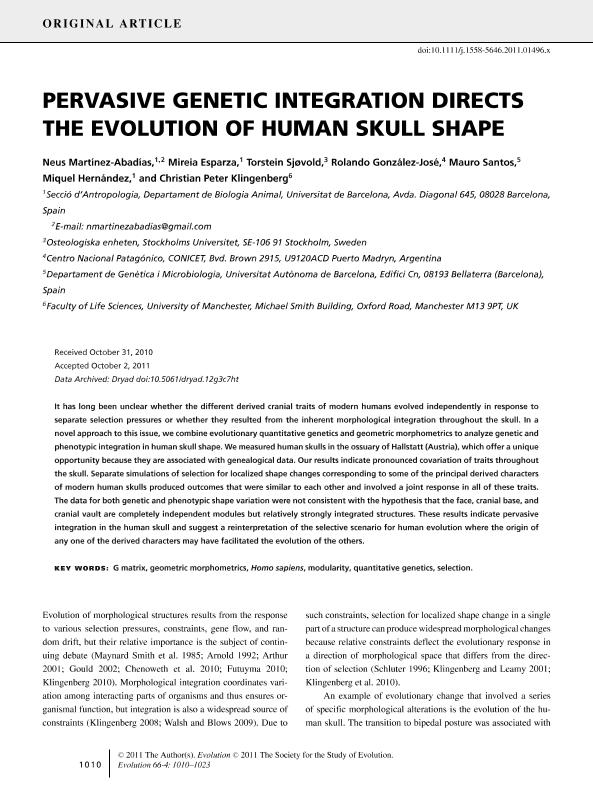Mostrar el registro sencillo del ítem
dc.contributor.author
Martínez Abadías, Neus
dc.contributor.author
Esparza, Mireia
dc.contributor.author
Sjovold, Torstein
dc.contributor.author
González José, Rolando

dc.contributor.author
Santos, Mauro
dc.contributor.author
Hernández, Miquel
dc.contributor.author
Klingenberg, Christian Peter
dc.date.available
2019-06-11T20:23:07Z
dc.date.issued
2012-04
dc.identifier.citation
Martínez Abadías, Neus; Esparza, Mireia; Sjovold, Torstein; González José, Rolando; Santos, Mauro; et al.; Pervasive genetic integration directs the evolution of human skull shape; Wiley Blackwell Publishing, Inc; Evolution; 66; 4; 4-2012; 1010-1023
dc.identifier.issn
0014-3820
dc.identifier.uri
http://hdl.handle.net/11336/77982
dc.description.abstract
It has long been unclear whether the different derived cranial traits of modern humans evolved independently in response to separate selection pressures or whether they resulted from the inherent morphological integration throughout the skull. In a novel approach to this issue, we combine evolutionary quantitative genetics and geometric morphometrics to analyze genetic and phenotypic integration in human skull shape. We measured human skulls in the ossuary of Hallstatt (Austria), which offer a unique opportunity because they are associated with genealogical data. Our results indicate pronounced covariation of traits throughout the skull. Separate simulations of selection for localized shape changes corresponding to some of the principal derived characters of modern human skulls produced outcomes that were similar to each other and involved a joint response in all of these traits. The data for both genetic and phenotypic shape variation were not consistent with the hypothesis that the face, cranial base, and cranial vault are completely independent modules but relatively strongly integrated structures. These results indicate pervasive integration in the human skull and suggest a reinterpretation of the selective scenario for human evolution where the origin of any one of the derived characters may have facilitated the evolution of the others.
dc.format
application/pdf
dc.language.iso
eng
dc.publisher
Wiley Blackwell Publishing, Inc

dc.rights
info:eu-repo/semantics/openAccess
dc.rights.uri
https://creativecommons.org/licenses/by-nc-sa/2.5/ar/
dc.subject
G Matrix
dc.subject
Geometric Morphometrics
dc.subject
Homo Sapiens
dc.subject
Modularity
dc.subject
Quantitative Genetics
dc.subject
Selection
dc.subject.classification
Otras Ciencias Biológicas

dc.subject.classification
Ciencias Biológicas

dc.subject.classification
CIENCIAS NATURALES Y EXACTAS

dc.title
Pervasive genetic integration directs the evolution of human skull shape
dc.type
info:eu-repo/semantics/article
dc.type
info:ar-repo/semantics/artículo
dc.type
info:eu-repo/semantics/publishedVersion
dc.date.updated
2019-03-08T16:44:41Z
dc.identifier.eissn
1558-5646
dc.journal.volume
66
dc.journal.number
4
dc.journal.pagination
1010-1023
dc.journal.pais
Reino Unido

dc.journal.ciudad
Londres
dc.description.fil
Fil: Martínez Abadías, Neus. Stockholms Universitet; Suecia. Universidad de Barcelona; España
dc.description.fil
Fil: Esparza, Mireia. Universidad de Barcelona; España
dc.description.fil
Fil: Sjovold, Torstein. Stockholms Universitet; Suecia
dc.description.fil
Fil: González José, Rolando. Consejo Nacional de Investigaciones Científicas y Técnicas. Centro Nacional Patagónico; Argentina
dc.description.fil
Fil: Santos, Mauro. Universitat Autònoma de Barcelona; España
dc.description.fil
Fil: Hernández, Miquel. Universidad de Barcelona; España
dc.description.fil
Fil: Klingenberg, Christian Peter. University of Manchester; Reino Unido
dc.journal.title
Evolution

dc.relation.alternativeid
info:eu-repo/semantics/altIdentifier/url/https://onlinelibrary.wiley.com/doi/full/10.1111/j.1558-5646.2011.01496.x
dc.relation.alternativeid
info:eu-repo/semantics/altIdentifier/doi/https://doi.org/10.1111/j.1558-5646.2011.01496.x
Archivos asociados
